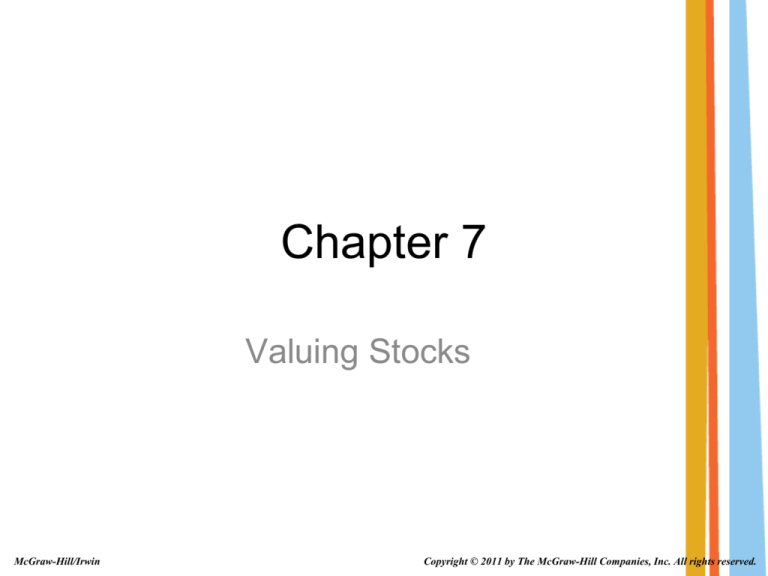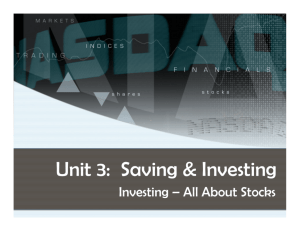
Chapter 7
Valuing Stocks
McGraw-Hill/Irwin
Copyright © 2011 by The McGraw-Hill Companies, Inc. All rights reserved.
Chapter 7 Learning Goals
LG1:
Understand common stock ownership
LG2:
Know how stock exchanges function
LG3:
Track the stock market with stock indices and differentiate among the
kinds of information each index provides
LG4:
Know the terminology of stock trading
LG5:
Compute stock values using dividend discount and constant-growth
models
LG6:
Calculate the value of a variable growth rate company
LG7:
Assess relative stock value using the P/E ratio model
2
Common Stock
• Equity securities (stocks) represent ownership
in a corporation
• Common stockholders are residual claimants
– The have a claim on cash flows only after all
other claimants (employees, suppliers,
debtholders, the government) have been paid
• At any point in time the market value of a
firm’s common stock depends on many factors
including:
–
–
–
–
The company’s profitability (cash flows)
The company’s growth potential
Current market interest rates
Conditions in the overall stock market
3
Stock Markets
• Stock exchanges provide liquidity: the
ability for owners of common stock to
convert their shares into cash at any
time
• This liquidity, allowing buyers and
sellers the means to transact with each
other, gives people the confidence to
buy shares in the first place
4
• New York Stock Exchange
– Largest U.S. stock exchange in terms of
dollar volume of trading
– Located in New York City at the corner of
Wall and Broad streets
– Home to nearly 2,700 listed firms
• Firms must meet listing requirements
• They must pay listing fees and annual fees to the
NYSE
– Trading Posts
• Specialists
• Brokers
5
6
• To list its stock on the NYSE a company
must meet minimum requirements for
–
–
–
–
Total number of stockholders
Level of trading volume
Corporate earnings
Firm size
• What if a firm doesn’t meet these criteria,
or doesn’t want to pay the high NYSE
fees?
– If they want to list on an organized exchange,
they could list on the exchange down the
street: the American Stock Exchange
7
• The American Stock Exchange (AMEX)
– The nation’s second largest floor-based stock
exchange
– Also called the ‘curb’ exchange
– Uses a specialist system like the NYSE
– Also active in trading derivative securities and
a very popular security called an Exchange
Traded Fund (ETF)
• What if a firm doesn’t need or want to be
traded on an organized, floor-based
exchange?
– They can trade over-the-counter on NASDAQ
8
• The Nasdaq Stock Market
– An electronic stock market without a
physical trading floor
– Home of thousands of the smallest
publicly-traded firms, as well as many
high-tech giants
• Microsoft, Apple, Intel, Google
– Nasdaq lists around 3,000 domestic and
foreign companies
– Second largest equity market in the world
behind the NYSE
9
• Rather than a physical trading floor,
Nasdaq uses an electronic trading
system
• Uses a market maker system rather
than a specialist system
– Market makers are located all over the
country
– Market makers act as dealers and buy
and sell securities using their own capital
and inventory
10
• Financial markets, including exchanges
are changing rapidly
– Many exchanges are shifting from
physical floor trading to electronic systems
– Exchanges are merging and becoming
larger, with an international focus
– Many exchanges have become public
companies themselves
• NYSE Euronext (NYX)
• Nasdaq (NDAQ)
11
Tracking the Stock Market
• With thousands of stocks trading every
minute, how do we determine the
overall direction of the market?
– We use stock indices
– There are dozens of stock indices used to
track different segments of the stock
market
– The three most-recognized indices are:
• The Dow Jones Industrial Average (DJIA)
• The Standard & Poor’s 500 Index (S&P500)
• The Nasdaq Composite Index
12
• The Dow Jones Industrial Average
– Invented in 1896, consisting of 12 companies
• The only surviving company from the original twelve is
General Electric
– Computed by adding up the stock prices and
dividing by the number 12
• The index is still a price-weighted average
– The DJIA now consists of 30 large firms,
representing 30 percent of the total U.S. stock
value
• Firms are occasionally added and deleted from the
average
• E.g. Altria Group and Honeywell were replaced by
Chevron and Bank of America on February 19, 2008
13
• The S&P 500 was created in 1957
– Intended to represent 10 sectors of the
economy
– Uses market capitalization to compute the
index rather than stock prices
• The S&P 500 index represents roughly 80
percent of the overall stock market value
– Considered to be superior to the DJIA
because of the much wider coverage and
the more useful way it is calculated
14
• The Nasdaq Composite Index
– Launched in 1971
– Like the S&P 500 index, it uses a market
capitalization weighted average
– Measures the market capitalization of all stocks
listed on the Nasdaq stock exchange
– Because of the dominance of the large high-tech
firms on Nasdaq, this index is considered a
measure of the performance of the technology
sector
15
Trading Stocks
• Brokerage Accounts
– Full-service vs. discount
• Buy and sell orders go through the
brokerage firm to a market maker or
specialist
• Bid/Ask spreads
– Bid price = price at which the dealer will
buy
– Ask price = price at which the dealer will
sell
– The bid/ask spread is the profit for the
market maker
16
• Types of Orders
– Market order
• Broker buys or sells at best price available at
the moment
– Limit order
• Order to buy or sell at a specific price
• Example: Suppose a share is currently selling
for $75
– Buy limit is at a price less than the current market
price. Place a limit order to buy at $72
– Sell limit is at a price greater than the current
market price. Place a limit order to sell shares you
own at $79
17
Basic Stock Valuation
• In the previous chapter we used
present value techniques to value
bonds
• We also use the present value to
determine the value of stocks
– The problem is that, unlike bonds, the
cash flows for stocks are not known
• Selling price
• Dividends
18
• Consider a two-year horizon:
D1
0
1
D2 + P2
2
• The present value of the cash flows in
years 1 and 2 is today’s stock value
D1 D2 P2
P0
2
1 i (1 i)
19
• In general, for any time horizon:
D1
D2
D n Pn
P0
...
2
n
1 i (1 i)
(1 i)
20
Dividend Discount Models
• We can extend the equation above for
an infinite stream of dividends and no
future selling price
• The stock’s value to the investor is the
present value of all future dividends
D3
D1
D2
P0
...
2
3
1 i (1 i)
(1 i)
21
• To use this model in practice, analysts make
a simplifying assumption to make the model
workable: constant perpetual growth
– This model is often called the Gordon growth
model
D0 (1 g )
D1
Constant growth model P0
ig
ig
– There are two important assumptions implicit in
this model: constant growth g and i>g
• If I is less than g, then the stock price is negative which
is nonsense
22
• Example: ACME stock recently paid a
$4.00 dividend. The dividend is expected
to grow at 9% per year indefinitely. What
would we be willing to pay if our required
return on ACME stock is 14%?
P0 =
D1
i-g
=
4.36
= $87.20
.14 - .09
23
Preferred Stock
Preferred stock is a hybrid security
• Like common stock it has no fixed
maturity
– It is technically part of equity capital
• Like debt , preferred dividends are fixed
• Preferred dividends are cumulative
– If a company misses preferred stock
dividends, they must make them up before
they can pay dividends to common
stockholders
24
• Preferred stock is owned primarily by other
companies rather than individuals
– Corporations can exempt 70 percent of dividend
income from taxes
• Preferred stockholders do not have voting
rights
• Preferred stock pays a constant dividend
– It is a special case of the constant perpetual
growth model in which g=0
– The formula collapses into the formula for the
present value of a perpetuity
25
• Coca-Cola’s dividend is $1.36 per
share at a time when the market price
of its stock is $63.50. What would the
value of Coke’s stock be if the
dividends were not expected to grow
(i.e. g=0)? The company’s cost of
capital is 11.5%.
P0 = 1.36/.115 = $11.83
– The difference between $63.50 and
$11.83 represents the market value of the
firm’s expected growth
26
Expected Return
• We can rearrange the constant growth
formula to solve for i, the expected
return on the stock
D1
Expected Return i
g Dividend yield Capital gain
P0
• Expected return comes from two
sources
– Dividend yield
– Expected appreciation of the stock price,
or capital gain
27
Additional Valuation Methods
• Variable Growth Techniques
– For high-growth firms, we can’t use the
constant growth formula because we
know that the firm can’t sustain the high
growth forever
– These firms may have two different
growth rates
• Growth during the supernormal growth period
• Steady growth after the firm matures
– We can use a multistage growth formula
for these firms, but we can also use
discounted cash flows in combination with
the constant growth model
28
• Example: Suppose a firm currently has
a dividend of D0 = $5. We expect the
firm to grow at a rate of 10% for three
years, after which it will grow at 4%
forever. The required return is 9%.
– First we can calculate the dividends:
•
•
•
•
D1 = 5(1+.10) = 5.50
D2 = 5.50(1.10) = 6.05
D3 = 6.05(1.10) = 6.655
D4 = 6.655(1.04) = 6.92
29
– Now we can calculate the present value of all
of the dividends in periods 4 to ∞, where the growth is
constant forever
P3 = D4/(i-g)
= 6.92/(.09-.04)
= 138.42
Now we have all the cash flows, and we can find P0
P0 = 5.50/1.091 + 6.05/1.092 + (6.655 + 138.42)/1.093
= $122.17
30
The P/E Model
• The models we have used so far
involve computing a stock’s intrinsic
value using discounted cash flows to
the investor
• Another approach is to assess a
stock’s relative value
• The price-earnings (P/E) ratio
represents the most common valuation
yardstick in the investment industry
31
• The P/E ratio is simply the current price of the
stock divided by the last four quarters of
earnings per share:
Current stock price
P/E
Per share earnings for last 12 months
• The P/E ratio is used as an indication of
expected growth of a company
– Larger growth rates lead to larger P/E ratios
– High P/E stocks are called growth stocks, whereas
low P/E stocks are called value stocks
32
• Estimating Future Stock Prices
– Multiplying the P/E ratio by expected
earnings results in an expected stock
price
n
P
Pn (
) x E0 x (1 g )
E
33
• Example: The P/E ratio for Caterpillar is
12.98. The company earned $5.05 per
share and paid a $1.10 dividend last year.
Analysts estimate that the company will
grow at an average annual rate of 12.8%
over the next 5 years. Calculate the
expected price of Caterpillar’s stock price
in 5 years.
P5 = (P/E) x E0 x (1 + g)5
= 12.98 x $5.05 x (1.128)5
= $119.70
34








